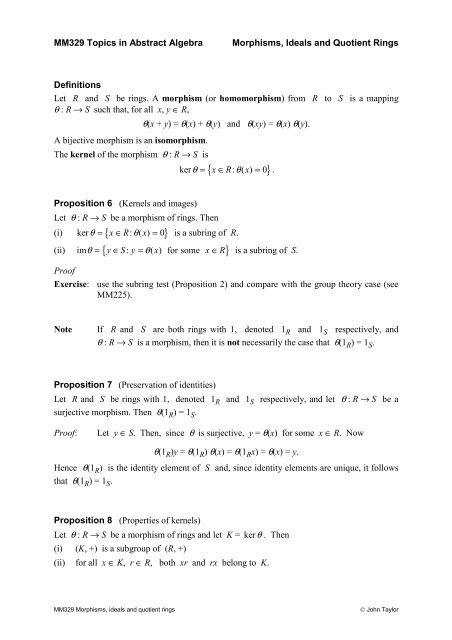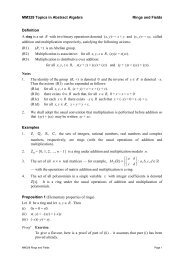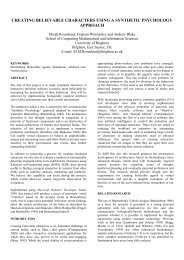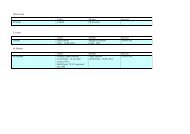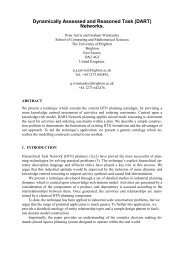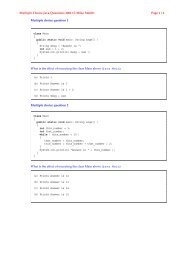Morphisms, ideals and quotient rings
Morphisms, ideals and quotient rings
Morphisms, ideals and quotient rings
You also want an ePaper? Increase the reach of your titles
YUMPU automatically turns print PDFs into web optimized ePapers that Google loves.
MM329 Topics in Abstract Algebra<br />
<strong>Morphisms</strong>, Ideals <strong>and</strong> Quotient Rings<br />
Definitions<br />
Let R <strong>and</strong> S be <strong>rings</strong>. A morphism (or homomorphism) from R to S is a mapping<br />
θ : R → S such that, for all x, y ∈ R,<br />
A bijective morphism is an isomorphism.<br />
The kernel of the morphism θ : R → S is<br />
θ(x + y) = θ(x) + θ(y) <strong>and</strong> θ(xy) = θ(x)=θ(y).<br />
{ θ }<br />
ker θ = x∈ R: ( x)<br />
= 0 .<br />
Proposition 6 (Kernels <strong>and</strong> images)<br />
Let θ : R → S be a morphism of <strong>rings</strong>. Then<br />
(i) ker θ = { ∈ : θ( ) = }<br />
x R x 0 is a subring of R.<br />
(ii) im θ = { y ∈ S: y = θ( x)<br />
x ∈R}<br />
for some is a subring of S.<br />
Proof<br />
Exercise:<br />
use the subring test (Proposition 2) <strong>and</strong> compare with the group theory case (see<br />
MM225).<br />
Note<br />
If R <strong>and</strong> S are both <strong>rings</strong> with 1, denoted 1 R <strong>and</strong> 1 S respectively, <strong>and</strong><br />
θ : R → S is a morphism, then it is not necessarily the case that θ(1 R ) = 1 S .<br />
Proposition 7 (Preservation of identities)<br />
Let R <strong>and</strong> S be <strong>rings</strong> with 1, denoted 1 R <strong>and</strong> 1 S respectively, <strong>and</strong> let θ : R → S be a<br />
surjective morphism. Then θ(1 R ) = 1 S .<br />
Proof:<br />
Let y ∈ S. Then, since θ is surjective, y = θ(x) for some x ∈ R. Now<br />
θ(1 R )y = θ(1 R )=θ(x) = θ(1 R x) = θ(x) = y.<br />
Hence θ(1 R ) is the identity element of S <strong>and</strong>, since identity elements are unique, it follows<br />
that θ(1 R ) = 1 S .<br />
Proposition 8 (Properties of kernels)<br />
Let θ : R → S be a morphism of <strong>rings</strong> <strong>and</strong> let K = ker θ . Then<br />
(i) (K, +) is a subgroup of (R, +)<br />
(ii) for all x ∈ K, r ∈ R, both xr <strong>and</strong> rx belong to K.<br />
MM329 <strong>Morphisms</strong>, <strong>ideals</strong> <strong>and</strong> <strong>quotient</strong> <strong>rings</strong><br />
© John Taylor
Proof<br />
(i) Group theory.<br />
(ii) Let x ∈ K, r ∈ R. Then<br />
θ(xr) = θ(x)=θ(r) (since θ is a morphism)<br />
= 0=θ(r) (since x ∈ K so θ(x) = 0)<br />
= 0.<br />
Therefore xr ∈ K.<br />
The proof that θ(rx) = 0 (<strong>and</strong> hence rx ∈ K) is similar.<br />
Definition<br />
Let R be a ring. A subset I of R is an ideal of R, written I k R , if<br />
(I1) (I, +) is a subgroup of (R, +)<br />
(I2) x ∈ I, r ∈ R ⇒ xr ∈ I <strong>and</strong> rx ∈ I.<br />
A proper ideal is an ideal I not equal to {0} or R; this is denoted I<br />
i R .<br />
Notes<br />
1. Every ideal I of R is a subring of R.<br />
2. The kernel of a morphism θ : R → S is an ideal of R (proposition 8).<br />
3. (I, +) is a normal subgroup of (R, +) since (R, +) is Abelian.<br />
By note 3, if I is an ideal of R, then the set of (right) cosets forms a group under addition;<br />
RI, + . We shall write the cosets of this group additively; that is,<br />
this is the <strong>quotient</strong> group ( )<br />
the coset containing r ∈ R will be denoted I + r or r + I:<br />
I + r = {x + r : x ∈ I} <strong>and</strong> RI = {I + r : r ∈ R}.<br />
Proposition 9 (Quotient <strong>rings</strong>)<br />
Let I be an ideal of a ring R. Then<br />
(i) RI is a ring<br />
(ii) the mapping π : R → RI, r I + r is a surjective morphism.<br />
Proof.<br />
Below.<br />
Example 12 = {0, 1, 2, …, 11}.<br />
Let I = {0, 3, 6, 9}. Then I is an ideal of 12 .<br />
Proof The set I contains all multiples of 3 in 12 .<br />
(I1) Clearly I ≠ ∅. The difference between any two multiples of 3 is also a<br />
multiple of 3; more precisely: x, y ∈ I ⇒ x – y ∈ I.<br />
MM329 <strong>Morphisms</strong>, <strong>ideals</strong> <strong>and</strong> <strong>quotient</strong> <strong>rings</strong> Page 2
It follows from the second subgroup test (MM225) that (I, +) is a subgroup<br />
of ( 12 , +).<br />
(I2) Let x be a multiple of 3; then any multiple of x is also a multiple of 3.<br />
More precisely, x ∈ I, r ∈ 12 ⇒ rx = xr ∈I.<br />
Therefore I is an ideal of 12 .<br />
The cosets are:<br />
Therefore:<br />
I = {0, 3, 6, 9} = I + 0 = I + 3 = I + 6 = I + 9<br />
I + 1 = {1, 4, 7, 10} = I + 4 = I + 7 = I + 10<br />
I + 2 = {2, 5, 8, 11} = I + 5 = I + 8 = I + 11.<br />
RI = {I, I + 1, I + 2}.<br />
The Cayley tables for RI under addition <strong>and</strong> multiplication are given below. The<br />
operations on cosets are:<br />
(I + r) + (I + s) = I + (r + s)<br />
(I + r)(I + s) = I + (rs)<br />
+ I I + 1 I + 2<br />
I<br />
I + 1<br />
I + 2<br />
× I I + 1 I + 2<br />
I<br />
I + 1<br />
I + 2<br />
The mapping π : R → RI defined in proposition 9 is:<br />
0 I, 1 I + 1, 2 I + 2,<br />
3 I, 4 I + 1, 5 I + 2,<br />
6 I, 7 I + 1, 8 I + 2,<br />
9 I, 10 I + 1, 11 I + 2,<br />
MM329 <strong>Morphisms</strong>, <strong>ideals</strong> <strong>and</strong> <strong>quotient</strong> <strong>rings</strong> Page 3
Proof of Proposition 9<br />
Suppose I is an ideal of R.<br />
(i) We know from group theory that ( RI, +) is an Abelian group.<br />
First we must show that multiplication on cosets is a well-defined operation. In other<br />
words, multiplication of cosets does not depend on the choice of labels for the cosets:<br />
if I + r 1 = I + r 2 <strong>and</strong> I + s 1 = I + s 2 then I + r 1 s 1 = I + r 2 s 2 .<br />
Suppose I + r 1 = I + r 2 <strong>and</strong> I + s 1 = I + s 2 .<br />
(ii)<br />
Then r 1 = r 2 + x for some x ∈ I <strong>and</strong> s 1 = s 2 + y for some y ∈ I.<br />
Now rs 11= ( r2 + x)( s2+<br />
y)<br />
= rs 22+ ry 2 + xs2+<br />
xy<br />
= rs + z<br />
22<br />
where z = r2y+ xs2 + xy.<br />
Now r 2 y ∈ I, xs 2 ∈ I <strong>and</strong> xy ∈ I (by property I2 of <strong>ideals</strong>).<br />
Therefore z ∈ I (by property I1 of <strong>ideals</strong>). It follows that I + r 1 s 1 = I + r 2 s 2 . Therefore<br />
multiplication of cosets is well-defined.<br />
Now the verification of axioms (R2) <strong>and</strong> (R3) is straightforward. Each follows from<br />
the corresponding axiom in R. For example, below is a verification of one of the<br />
distributive laws.<br />
Let I + r, I + s, I +t ∈ RI. Then<br />
( ) ( )<br />
( I + r) ( I + s) + ( I + t) = ( I + r) I + ( s+<br />
t)<br />
= I + r( s+<br />
t)<br />
= I + ( rs+<br />
rt)<br />
= ( I + rs) + ( I + rt)<br />
= ( I + r)( I + s) + ( I + r)( I + t).<br />
The other verifications are left as an exercise.<br />
Therefore RI is a ring.<br />
It is now easy to check that π is a morphism:<br />
π(r + s) = I + (r + s) = (I + r) + (I + s) = π(r) + π(s)<br />
<strong>and</strong> π(rs) = I + (rs) = (I + r)(I + s) = π(r)π(s).<br />
Since every element of RI is of the form I + r = π(r) for some r ∈ R, it follows<br />
that π is surjective.<br />
Proposition 10<br />
Let R be a ring with 1 <strong>and</strong> let I be an ideal of R. Then the <strong>quotient</strong> ring RI has identity<br />
I + 1.<br />
Proof<br />
By proposition 9 (ii), π is a surjective morphism. The result now follows from proposition 7.<br />
MM329 <strong>Morphisms</strong>, <strong>ideals</strong> <strong>and</strong> <strong>quotient</strong> <strong>rings</strong> Page 4
Proposition 11<br />
Let R be a ring with 1 <strong>and</strong> let I be an ideal of R. If 1 ∈ I then I = R.<br />
Proof<br />
Suppose I is an ideal of R <strong>and</strong> 1 ∈ I. Then, for all r ∈ R, r = 1.r ∈ I (by property I2 of<br />
<strong>ideals</strong>). Therefore I = R.<br />
Proposition 12<br />
A field has no proper <strong>ideals</strong>.<br />
Proof<br />
Let F be a field <strong>and</strong> let I ≠ {0} be an ideal of F. Then there exists x ∈ I, x ≠ 0.<br />
Since F is a field, x has an inverse x –1 ∈ F.<br />
Now x ∈ I <strong>and</strong> x –1 ∈ F so xx –1 ∈ I (by property I2 of <strong>ideals</strong>). Hence 1 ∈ I, so I = F,<br />
by proposition 11.<br />
Proposition 13<br />
Let θ : F → R be a ring morphism where F is a field.<br />
Them θ is either injective or trivial (maps everything to 0).<br />
Proof<br />
Since K = kerθ is an ideal of F, it follows from proposition 12 that K = {0} or K = F.<br />
Therefore θ is injective or trivial (respectively).<br />
Proposition 14 (First isomorphism theorem for <strong>rings</strong>)<br />
(i) Let θ : R → S be a surjective morphism of <strong>rings</strong> <strong>and</strong> let K = kerθ . Then<br />
RK<br />
≅ S.<br />
(ii)<br />
Let θ : R → S be a morphism of <strong>rings</strong> <strong>and</strong> let K = kerθ . Then<br />
RK≅ imθ .<br />
Proof Part (ii) follows from part (i), so we prove part (i) only.<br />
Suppose θ : R → S is a surjective morphism of <strong>rings</strong> <strong>and</strong> let K = kerθ .<br />
Define φ : RK→ S by φ : K+<br />
r θ( r)<br />
.<br />
The mapping φ is illustrated in the following diagrams.<br />
R<br />
θ<br />
S<br />
r<br />
θ<br />
θ(r)<br />
π φ =====π φ<br />
RK I + r<br />
MM329 <strong>Morphisms</strong>, <strong>ideals</strong> <strong>and</strong> <strong>quotient</strong> <strong>rings</strong> Page 5
From the first isomorphism theorem for groups, φ is an isomorphism of the additive groups:<br />
( RK, + ) ≅ ( S, + ). It only remains to show that φ is a morphism of <strong>rings</strong>; i.e. that φ<br />
preserves multiplication.<br />
φ( ( I + r)( I + s) ) = φ( I + rs)<br />
= θ( rs) ( definition of φ)<br />
= θ()() s θ s ( θ is a morphism)<br />
= φ( I + r) φ( I + s).<br />
Therefore φ is an isomorphism of <strong>rings</strong>, so RK<br />
≅ S.<br />
Proposition 15<br />
A field has no ‘proper’ <strong>quotient</strong> <strong>rings</strong>. More precisely, if F is a field <strong>and</strong> FI is a <strong>quotient</strong><br />
FI≅<br />
F or FI≅<br />
0 .<br />
ring, then { }<br />
Proof<br />
This follows immediately from proposition 12.<br />
MM329 <strong>Morphisms</strong>, <strong>ideals</strong> <strong>and</strong> <strong>quotient</strong> <strong>rings</strong> Page 6


